#Flying Machine
Explore tagged Tumblr posts
Text
Soaring into history 🛩️Wilbur and Orville Wright

Soaring into history on December 17, 1903, Wilbur and Orville Wright achieved the first successful flight of a heavier-than-air aircraft near Kitty Hawk, North Carolina. Their revolutionary Wright Flyer soared for just 12 seconds on its maiden voyage.
The Wright brothers' invention was officially recognized when they were granted U.S. Patent No. 821,393 on May 22, 1906, for their "Flying Machine."

This patent, preserved in the records of the National Archives, laid the foundation for their innovative three-axis control system, which allowed a pilot to steer the aircraft effectively. This key innovation remains a fundamental principle in aviation to this day.

321 notes
·
View notes
Text

Blas Gallego's 1988 cover for Kiteworld, by Keith Roberts
403 notes
·
View notes
Text
Memory

"I have always felt it is my destiny to build a machine that would allow man to fly."
Leonardo da Vinci ~~~~~~~~~~~~~~~~~~~~~~~~
Please enjoy this fill for a really old IPAT prompt: Memory. Sorry, no limerick this time, because I spent so many hours on putting together this little diorama for a HAPPY MEMORY from our Ineffables' shared history.
Please feel free to take this picture as a prompt to write your own fanfiction or create some fanart! 😘
For more ramblings and credits...
The above Da Vinci diorama was heavily inspired by this beautiful canon piece of art that was brought back to my attention a couple of weeks ago:

(Credit goes to Paul Kidby. You can read more about it here).
To me the fact that Leonardo Da Vinci created this lovely double portrait of Aziraphale and Crowley in the canon GO universe is a strong indicator that they all knew each other well (you get to decide how well). So in my headcanon they might have spent some time together having fun, "sciencing out" in Leonardo's workshop. The idea is not too far-fetched, right?
While Crowley surely must have gotten a blast out of humans trying to invent clever machines that let them fly and testing them himself of course, Aziraphale would surely have appreciated all the marvelous scientific papers!
My LEGO Ineffables' hairstyles are strongly inspired by Paul Kidby's (fake) historical drawing, but I decided to go with less formal outfits here, since I really wanted to show a fun and informal meeting of friends rather than anyone dressing up to have their portrait painted!
Honestly, I can't believe how crammed this set ended up! There are so many little gimmicks hidden (some in plain sight, but out of focus, and some pretty much invisible) that I just gave up catching it all in one picture.
No, I don't expect anyone to admire the stained glass window or the bloody whimsical staircase, but please take a closer look at the piece of art Leonardo is currently working on; you might have seen it elsewhere on the show! Well, Leonard is trying to work on it... guess it's hard to get anything done while a demon is zooming through your workshop with a flying machine! 😉
It took quite a lot of fiddling to get the wings positioned like that, but I really wanted Crowley to stretch a wing over Aziraphale's head for reasons. 🥹
A huge shout-of goes to AREA-X (SEMBO) for providing their wonderful INSPIRATION FROM ART - GREAT ARTIST DIORAMA SERIES, feat. this Leonardo Da Vinci set I used to 'Good Omify' (that's not a word, but it should be) his space!
It was great fun to build, even if the staircase must have been designed in hell! The rest of it, though, feels and looks heavenly! There are so many gorgeous prints, awesome custom pieces, and teeny-tiny details that are barely visible once everything is fully assembled! A Metallic Gold frog sitting below the staircase and looking out the stained glass window? Sure, why not? I love it! 😂
~~~~~~~~~~~~~~~~~~~~~~~~
@ineffablyruined I hope you enjoy this little interpretation of a happy memory that surely must exist in the canon Good Omens universe, even if we haven't seen it on the show! 🥰
#lego photography#good omens#good omens lego#lego omens#ineffable lego#lego diorama#good omens diorama#ipat#ineffablepromptathon#ineffablepat#prompt-a-thon#week twenty-two: memory#week twenty-two#prompt: memory#ineffable husbands#ineffable husbands lego#crowley lego#aziraphale lego#custom lego#area-x#leonardo da vinci#paul kidby#da vinci portrait of aziraphale and crowley#crowley's mona lisa#headcanon#historical#flying machine#wings#fun#happy
83 notes
·
View notes
Text

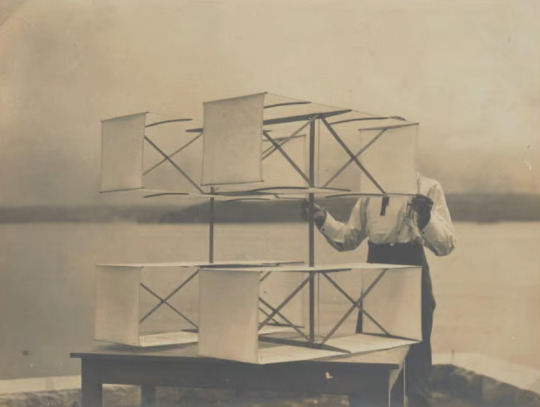
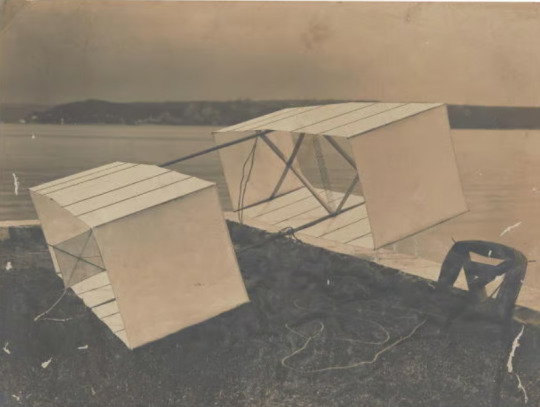

Photograph of Lawrence Hargrave kneeling beside box kite at Woollahra Point
Photograph of Lawrence Hargrave standing beside a cellular kite on a table at Woollahra Point
Photograph of a cellular kite and kite winder at Woollahra Point from the William Hudson Shaw Archive
Photograph of Lawrence Hargrave flying a cellular kite at Woollahra Point
89 notes
·
View notes
Photo

Source details and larger version.
Uplifting: my modest collection of vintage flying horses.
45 notes
·
View notes
Text
Da Vinci flying machine
Da Vinci Flying Machine 10363 - a set that is my second technological masterpiece after the ornithocopter. When the announcement appeared and the set appeared in the store, I knew it would end up in front of the lens.




#brickcentral#lego#lego photography#afol#legophotography#toyphotography#legography#legomania#minifigures#minifigs#da vinci#flying#flying machine
22 notes
·
View notes
Video
youtube
Winged Sea MONSTERS: The Ekranoplan, Bizarre Flying Machines & The Origin Of Seaplanes
#youtube#ekranoplan#bartini#caspian#flying machine#ussr#cold war history#cold war aircraft#cold war#cold war era#seaplane#engineering#prototype#russia#aviation#aircraft
16 notes
·
View notes
Text









---
Snork (90s Moomins) Stimboard
Made for: @sandysandwhiches1000
I hope you like this. :) I added some autism related stims for your headcanon.
Credits: x x x | x x x | x x x

#gilear's creations#stimblr#stimboard#visual stim#stimmy#stim#gif#gifs#gif warning#the moomins#moomins#snork moomins#90s moomin#science#inventor#engineering#inventions#tech#brown#bronze#white#silver#stem#autistic headcanon#flying machine#gears#metal#clockwork
17 notes
·
View notes
Text
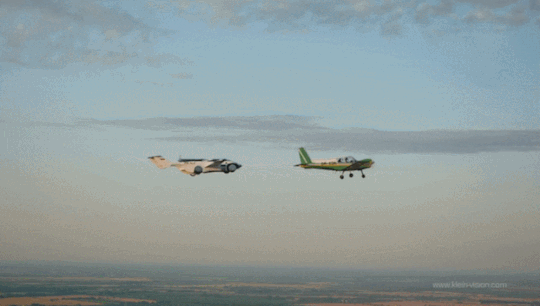




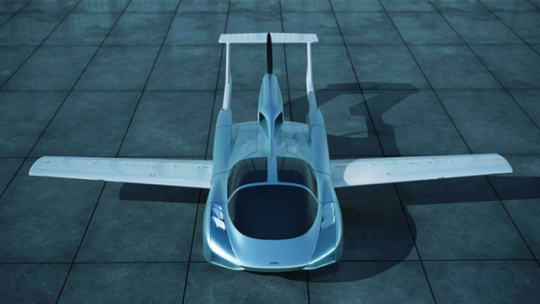




Klein Vision's AirCar !
The AirCar will be certified and ready for sale by Q1 of 2026 !
#art#design#flying private#travels#luxury lifestyle#flying palace#jetsetter#jetset#flying cars#flying car#klein vision#aircar#flying machine#billionaire#billionairelife#gif#animated gif
9 notes
·
View notes
Text

Flying high over the little factory town
#fantasy artwork#fantasy#fantasy art#fantasy aesthetic#steampunk#steampunk fantasy#steampunk art#steampunk artwork#steampunk aesthetic#pencildrawing#pencil art#pencil sketch#traditional drawing#traditional art#traditional#pencil#steampunk fashion#flying machine#flying machines#gaslamp fantasy
22 notes
·
View notes
Text

The Birdman Rally in Canberra, Australia. (1985-92)
#canberra#australia#vintage#flying machine#1980s#1990s#vintage australia#20th century#world capitals#vintage photo
18 notes
·
View notes
Text

Sweet Dreams and Flying Machines in Pieces on the Ground by Rachel Dworkin, Archivist
The concept behind the helicopter is centuries old and dates at last as far back as 400 BC in China where children played with bamboo flying toys. Basically, the spinning of the rotor blades produces a downward pressure which, in turn, provides lift. In the 1480s, Leonardo De Vinci created designs for a flying machine, but the lack of an available working engine meant it never got off the page let alone the ground. The first truly functional helicopter was the Focke-Wulf Fw 61 designed by Professor Henrich Focke in 1936 and the first large-scale production of helicopters was undertaken by Sikorsky Manufacturing Company beginning in 1942. (READ MORE)
2 notes
·
View notes
Text

off to work (via adski-kaeferti)
3 notes
·
View notes
Text
Twenty-Five Years Before The Wright Brothers Took To The Skies, This Flying Machine Captivated America
First Exhibited in 1878, Charles F. Ritchel’s Dirigible Was About As Wacky, Dangerous and Impractical as Any Airship Ever Launched
— June 11, 2024 | Erik Ofgang

“When I Was Making It, People Laughed at Me a Good Deal,” Charles F. Ritchel Later Said. “But Do They Did at Noah When He Built the Ark.” Illustration by Meilan Solly/Images via Wikimedia Commons under public domain, Newspapers.com
Charles F. Ritchel’s Flying Machine Made a Sound Like a Buzzsaw as its pilot turned a hand crank to spin its propeller. It was June 12, 1878, and a huge crowd, by some accounts measuring in the thousands, had gathered at a baseball field in Hartford, Connecticut. The spectators had each paid 15 cents for a chance to witness history.
The flying machine—if one could really call it that—was an unsightly jumble of mechanical parts. It consisted of a 25-foot-long, 12-foot-wide canvas cylinder filled with hydrogen and bound to a rod. From this contraption hung a framework of steel and brass rods that the Philadelphia Times likened to “the skeleton of a boat.” The aeronaut would sit on this framework as though it were a bicycle, controlling the craft with foot pedals and a hand crank that turned a four-bladed propeller.
The device did not inspire confidence.
“When I was making it, people laughed at me a good deal,” Ritchel later said. “But so they did at Noah when he built the ark.”
A self-described “professor,” Ritchel was the inventor of such wacky, weird and wild creations that a recounting of his career reads as though it were torn from the pages of a Jules Verne novel. Supposedly friends with both P.T. Barnum and Thomas Edison, Ritchel for a time made a living working for a mechanical toy company in Bridgeport, Connecticut, where he designed talking dolls, model trains and other playthings. But he was more than just a toymaker.

Left: Charles F. Ritchel filed more than 150 patents over his lifetime. Right: Ritchel's 1878 patent for his flying machine — Photographs: Public Domain Via Wikimedia Commons
Some years after the flying machine demonstration, the inventor proposed an ambitious attraction for the 1893 World’s Columbian Exposition (also known as the Chicago World’s Fair): a “telescope tower” that would rival France’s Eiffel Tower. The design consisted of a 500-foot-wide base topped by multiple nested structures that rose up over the course of several hours, eventually reaching a height of about 1,000 feet. After this proposal was rejected, Ritchel launched a campaign to raise funds to build a life-size automaton of Christopher Columbus, which the Chicago Tribune reported would speak more than 1,000 phrases in a human-like voice, rather than the “far-away, metallic sounds produced by a phonograph.”
By the mid-1880s, Ritchel claimed to have filed more than 150 patents. Not all of them were fun. He invented more efficient ways to kill mosquitos and cockroaches, a James Bond-esque belt that assassins could use to inject poison into their targets, and a gas bomb for use in land or naval warfare.
Yet never in his career was his quirk-forward blend of genius and foolishness more apparent than on that June day in Hartford. Because the balance of weight and equipment was so delicate, Ritchel was too heavy to fly the craft. Instead, he employed pilot Mark W. Quinlan, who tipped the scale at just 96 pounds. Quinlan was a 27-year-old machinist and native of Philadelphia, but little else is known about him. The record, however, is crystal clear on one count: Quinlan was very, very brave.
When preparations for the craft were complete, the crowd watched in eager anticipation as Quinlan boarded the so-called pilot’s seat. The airship rose 50 feet, then 100 feet, then 200 feet. Such a sight was uncommon but not unheard of at the time. The real question was: Once the craft was in the air, could it be controlled?
The first heavier-than-air flight (in which airflow over a surface like a plane wing creates aerodynamic lift) only took place in 1903, when the Wright Brothers conducted their famous flight in Kitty Hawk, North Carolina. But by the late 19th century, flying via lighter-than-air gases was already close to 100 years old. (This method involves heating the air inside of a balloon to make it less dense, leading it to rise, or filling the balloon with a low-density gas such as helium or hydrogen.) On November 21, 1783, Jean-François Pilâtre de Rozier and François Laurent d’Arlandes completed the first crewed, untethered hot-air balloon flight, passing over Paris on a craft built by the Montgolfier brothers. Later, balloons were used for reconnaissance during the French Revolutionary Wars and the American Civil War.

A drawing of the Montgolfier brothers' hot-air balloon Public Domain Via Wikimedia Commons
But free-floating balloons were, and still are, at the mercy of the winds. While balloon aeronauts can achieve limited control by changing altitude and attempting to catch different currents, they can’t easily return to the spot where they took off from, which is why even today, they have teams following them on the ground. Mid-1800s aviation enthusiasts dreamed of fixing this problem, which led to the development of dirigibles—powered, steerable airships that were inflated with lighter-than-air gases. (The word dirigible comes from the French word diriger, “to steer”; contrary to popular belief, the term, which is synonymous with airship, is not derived from the word “rigid.”) While some early aeronauts successfully steered dirigibles, none of these rudimentary airships could truly go against the wind or provide a controlled-enough flight to take off and land at the same point consistently.
In 1878, Ritchel was unaware of anyone who had successfully taken off in a dirigible and landed at the same spot. He hoped to change that with his baseball field demonstration. A month earlier, Ritchel had exhibited the airship’s capabilities during indoor flights at the Philadelphia Main Exhibition Hall, a massive structure built for that city’s 1876 Centennial Exposition. But there is no wind indoors, and the true test of his device would have to be performed outdoors.
After rising into the air, Quinlan managed to steer the craft out over the Connecticut River. To onlookers, it was clear that the aeronaut was in control. But as he flew, the wind picked up, and it began to look like a storm was gathering. To avoid getting caught in the poor weather and facing an almost-certain disaster, Quinlan steered the craft back toward the field, cutting through the “teeth of the wind until directly over the ball ground whence it had ascended, and then alighted within a few feet of the point from which it had started,” as the New York Sun reported.

Ritchel's dirigible, as seen on the July 13, 1878, cover of Harper's Weekly Public Domain Via Wikimedia Commons
The act was hailed far and wide as a milestone. An illustration of the impressive-looking flying machine was featured on the cover of Harper’s Weekly.
“The great problem which inventors of flying machines have always before them is the arrangement by which they shall be able to propel their frail vessels in the face of an adverse current,” the magazine noted. “Until this end shall have been achieved, there will be little practical value to any invention of the kind. In Professor Ritchel’s machine, however, the difficulty has been in a great measure overcome.”
Across the country, observers hailed Ritchel’s odd but impressive milestone in flight. In the years and decades that followed, this achievement was forgotten by almost all except a select group of aviation historians.
Wikipedia incorrectly lists the flight of the French army dirigible La France as the first roundtrip dirigible flight. But this event took place six years after Ritchel’s Hartford demonstration, in August 1884. Why has a flight so seemingly monumental in its time been relegated to the dustbin of history?
Given his eccentric nature and creativity, it’s easy to root for Ritchel and think of him as a Nikola Tesla-like genius robbed of his rightful place in history. The reality of why his feat was forgotten is more complicated. As Tom Crouch, an emeritus curator at the Smithsonian’s National Air and Space Museum, says, it’s possible Ritchel’s craft was the first to complete a round-trip dirigible flight. But other aircraft in existence at the time probably could have accomplished the same feat in favorable conditions. “La France made the first serious round-trip,” Crouch says.
Additionally, while Ritchel’s machine worked to a point, it wasn’t a pathway to more advanced dirigibles. Richard DeLuca, author of Paved Roads & Public Money: Connecticut Transportation in the Age of Internal Combustion, points out that the hand-cranked nature of Ritchel’s craft made it nearly impossible to operate with any kind of wind. “On the first day, he got away with it and directed the ship out and over the river and back to where he started, and that was quite an accomplishment,” DeLuca says. “But the conditions were just right for him to do that.”
Dan Grossman, an aviation historian at the University of Washington, has never come across evidence that any later pioneers of more advanced dirigible flights were influenced by Ritchel. “There are a lot of firsts in history that got forgotten because they never led to a second,” Grossman says.
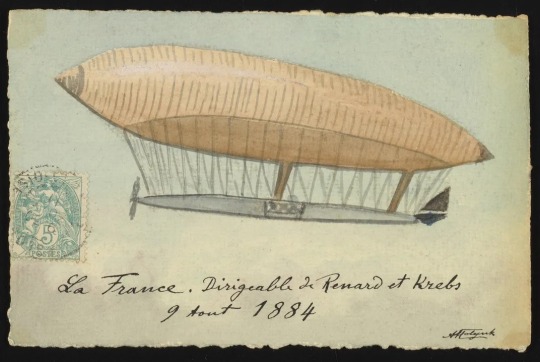
An artist's depiction of the La France airship Public Domain Via Wikimedia Commons
The day after their first successful public outdoor flight in Hartford, Quinlan and Ritchel tried again at that same ballfield. This time, the weather was less cooperative, and the wind came in sharp gusts. Still, the pair persisted in their attempt. “Little Quinlan, even if he does only weigh 96 pounds, has confidence and nerve enough to go up in a gale,” the Sun reported. Up he went about 200 feet, but this time, the wind carried him away with more force. Quinlan was “seen throwing his vertical fan into gear, and by its aid, the aerial ship turned around, pointing its head in whatever direction he chose to give it.” Although he could move the ship about, “he could not make any headway against the strong wind.”
Quinlan descended about 100 feet, trying to catch a different current, but the wind still pushed him away from the ballfield. He raised the craft, this time going higher than 200 feet, but still couldn’t overcome the wind and was soon swept off toward New Haven, vanishing from sight like some real-world Wizard of Oz.
Eventually, Quinlan safely brought the airship down in Newington, about five miles away from Hartford. The inventor and his pilot were unfazed by this setback. They held more public exhibitions that year with a mix of success and failure—including an incident that nearly cost Quinlan his life. During a July 4 exhibition in Boston, the machine malfunctioned and continued to rise, soaring to what the Boston Globe estimated to be 2,000 feet. Quinlan couldn’t get the propeller to work, and the craft continued to rise, reaching as high as 3,000 feet.
youtube
Terrified but quick-thinking, Quinlan tied his wrist and ankle to the craft and swung out of his seat to fix the propeller, using a jack-knife he happened to have on him as a makeshift tool. The daring midair repairs worked, and the craft gradually descended. Quinlan landed in Massachusetts, 44 miles from his starting destination, after a 1-hour, 20-minute flight.
Per Grossman, the human-powered method Ritchel attempted to utilize was doomed from the start. “In the absence of an internal combustion engine, there really was no control of lighter-than-air flight,” he says.
Ritchel stubbornly refused to consider powering dirigibles with engines and did not foresee how powerful a better-designed aircraft truly could be.
“I have overcome the fatal objection of which has always been made to the practicability of aerial navigation—that is, I have made a machine that can be steered,” Ritchel told a reporter in July 1878. “I claim no more. I have never pretended that a balloon can be made to go against the wind, and I am sure it never could. It is as ridiculous as a perpetual motion machine, and the latter will be invented just as soon as the former.”
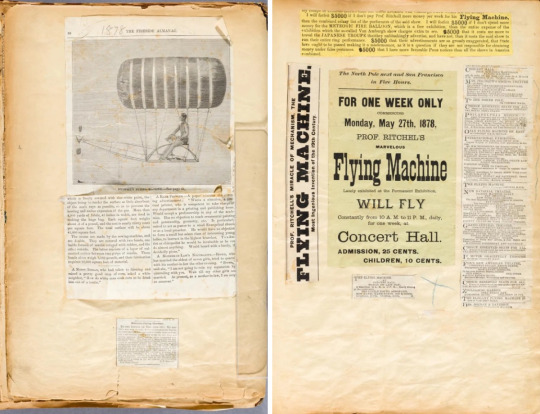
Left: A page from Ritchel's ballooning scrapbook National Air and Space Museum Archives. Right: The scrapbook covers the years 1878 to 1901. Photographs: National Air and Space Museum Archives
Even so, Ritchel was influential in his own way. “He was one of the first to really come up with the notion of a little one-man, bicycle-powered airship, and those things were around into the early 20th century,” says Crouch. After Ritchel, other daring inventors launched similar pedal-powered airships. Carl Myers, for example, held demonstrations of a device he called the “Sky-Cycle” in the 1890s.
Ritchel stands as one of the fascinating early aeronauts whose work blurred the line between science and the sideshow. “I refer to them as aerial showmen, these guys who came up with the notion of making money [by] thrilling people [with] their exploits in the air,” Crouch says.
According to Crouch’s 1983 book, The Eagle Aloft: Two Centuries of the Balloon in America, Ritchel and Quinlan took the airship on tour with a traveling circus in the late 1870s. Ritchel also operated his machine at Brighton Beach near Coney Island. He sold a few replicas of his device and later attempted to develop a larger, long-distance version of the craft powered by an 11-person hand-cranking crew. Perhaps unsurprisingly, this idea failed to gain momentum, and Ritchel faded from the headlines. Soon, the exploits of new aeronauts would upstage him, among them Alberto Santos-Dumont’s circumnavigation of the Eiffel Tower in 1901.

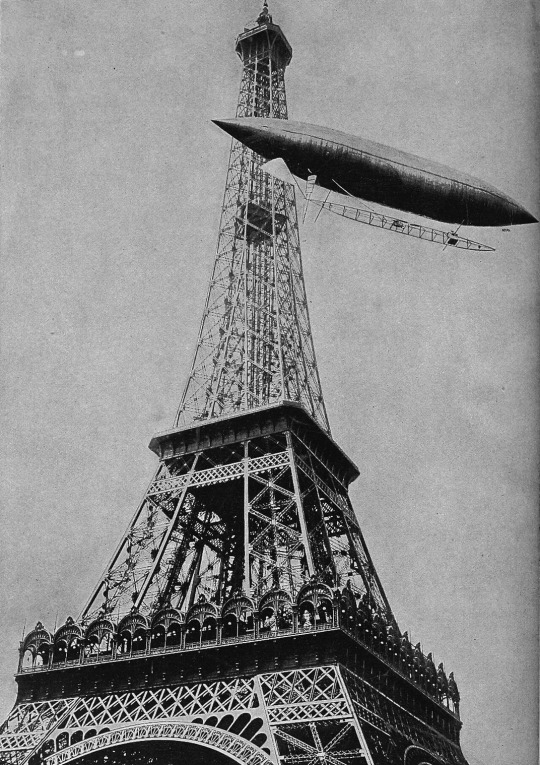
Left: Alberto Santos-Dumont's first balloon, 1898. Right: Santos-Dumont circles the Eiffel Tower in an airship on July 13, 1901. Photographs: Public Domain Via Wikimedia Commons
Despite many earlier dirigible flights, Crouch and Grossman agree that the technology only became practical when German Count Ferdinand von Zeppelin built and flew the first rigid dirigible in the early 1900s. Over the first decade of the new century, Zeppelin perfected his namesake design, which featured a fabric-covered metal frame that enclosed numerous gasbags. “By 1913, just before [World War I] begins, Zeppelin is actually running sightseeing tours over German cities,” Crouch says, “so the Zeppelin at that point can safely carry passengers and take off and land from the same point.”
For a brief period, airships ruled the sky. (The spire of New York City’s Empire State Building, built in the 1930s, was famously intended as a docking station for passenger airships.) But the vehicles, which use gas to create buoyancy, were quickly eclipsed by airplanes, which achieve flight through propulsion that generates airflow over the craft’s wings.
While the 1937 Hindenburg disaster is often viewed as the end of the dirigible era, Grossman says that’s a misconception: The real death knell for passenger airships arrived when Pan American Airways’ China Clipper, a new breed of amphibious aircraft, flew from San Francisco to Manila in November 1935. “Partly because they flew faster, they could transport more weight, whether it’s people or cargo, mail, whatever, in the same amount of time,” Grossman explains. “They were less expensive to operate, they required much, much smaller crews, [and] they were less expensive to build.”
Airplanes were also safer. “Zeppelins have to fly low and slow,” Crouch says. “They operate in the weather; airplanes don’t. An airplane at 30,000 feet is flying above the weather. Weather, time after time, is what brought dirigibles down.”
Today, niche applications for passenger airships endure, including the Zeppelin company’s European tours, as well as ultra-luxury air yachts and air cruises. But “it’s always going to be a tiny, tiny slice of the transportation pie,” Grossman says.
Crouch agrees. “People still talk about bringing back big, rigid airships. That hasn’t happened yet, and I don’t think it will,” he says.

The USS Los Angeles, a United States Navy airship, in 1931. Photograph Public Domain Via Wikimedia Commons
In some ways, Ritchel’s flying machine was a microcosm of the larger history of dirigibles: fascinating, fun and the perfect fodder for fiction, but ultimately eclipsed by more efficient technology.
As for Ritchel, he died, penniless, of pneumonia in 1911 at age 66. “Although during his lifetime he had perfected inventions that, in the hands of others, had brought in great wealth, he died a poor man, as he lacked the business ability to turn the children of his brain to the best advantage to himself,” wrote the Bridgeport Post in his obituary.
Even so, the public had not forgotten the brief time three decades earlier when Ritchel and his airship ruled the skies. As the Boston Evening Transcript reported, his flights captured “the attention of the world. In every country and in every language, newspapers and magazines of the day printed long stories of the wonderful feats performed by the Bridgeport aviator and his marvelous machine, of which nothing short of a cruise to the North Pole was expected.”
— Erik Ofgang is the co-author of The Good Vices: From Beer to Sex, The Surprising Truth About What’s Actually Good For You and the author of Buzzed: A Guide to New England's Best Craft Beverages and Gillette Castle: A History. His work has appeared in the Washington Post, the Atlantic, Thrillist and the Associated Press, and he is the senior writer at Tech & Learning magazine.
#Youtube#Air & Space Museum#Air Transportation#Airplanes ✈️ ✈️ ✈️#American 🇺🇸 History#Invention#Newspapers 📰 🗞️#Smithsonian Institution#Toys#Transportation#Wright Brothers#Flying Machine#Charles F. Ritchel#Airship#Professor Charles F. Ritchel#Inventer of the Only Flying Machine on Earth 🌎#Lardner & Co | 1319 Chestnut Street | Philadelphia | Pennsylvania
10 notes
·
View notes
Text
Ornithopters in visual media.
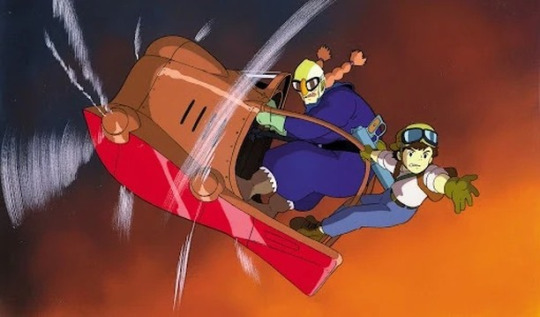


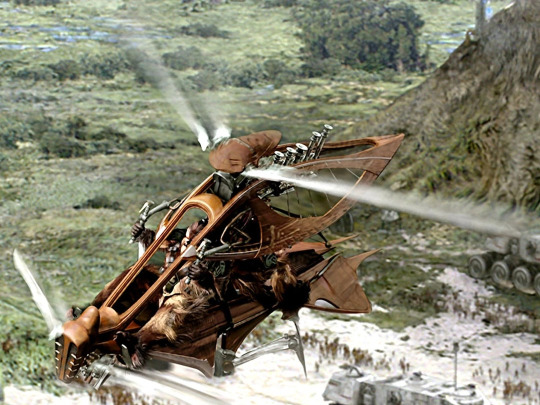
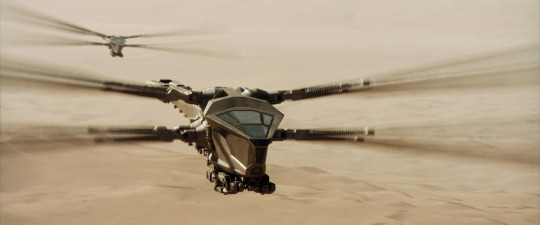
#flying machine#ornithopter#sci fi#fantasy#steampunk#studio ghibli#laputa#castle in the sky#howl's moving castle#sky captain and the world of tomorrow#star wars episode iii: revenge of the sith#dune
14 notes
·
View notes
Text

The balloonists - Accidental Renaissance
#Balloonist#hot air balloon#accidental renaissance#reddit#Aeronautics#Bertrand Piccard#rozier#Montgolfier brothers#sky lantern#manned flight#blimp#hot air balloon festival#balloon festival#Felix Baumgartner#flying machine#zeppelin
3 notes
·
View notes